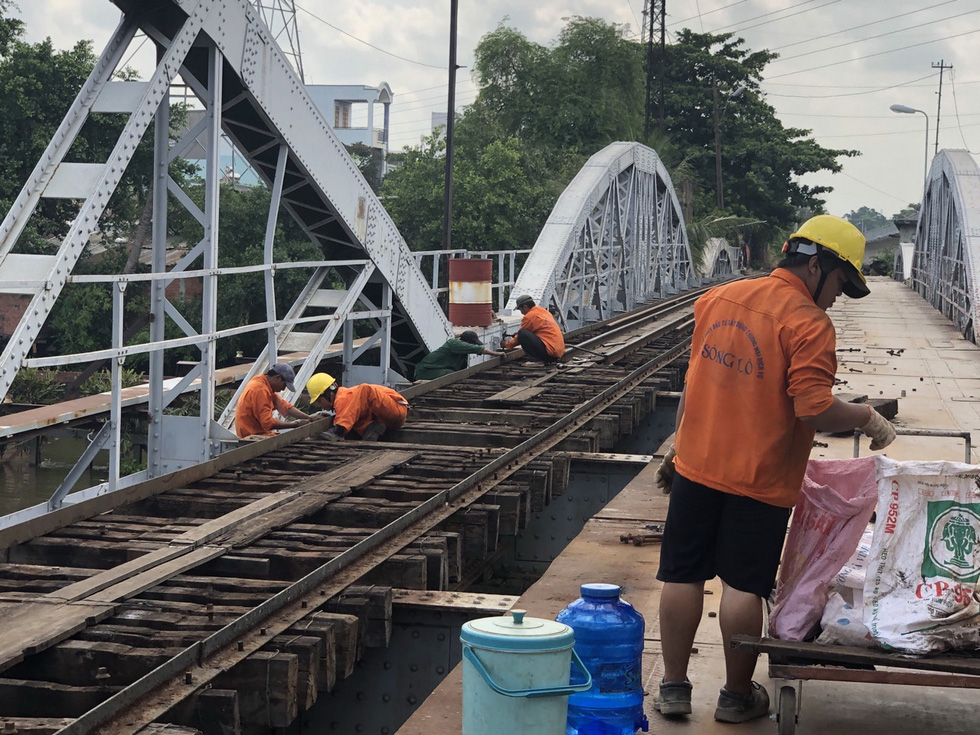Work to dismantle the old Binh Loi Railway Bridge connecting Ho Chi Minh City’s Thu Duc and Binh Thanh Districts began this week as part of efforts to develop the city’s water transport.
Built in 1902, the 276-meter railway bridge featuring six spans was the first of its kind to cross the Saigon River.
While the bridge has a historical value, it is crucial to replace it with a modern one as the old bridge’s vertical clearance was only 1.8 meters, which posed an obstacle for boats traveling underneath.
According to the Ho Chi Minh City Department of Transport, the bridge’s dismantlement that started on Friday is expected to be done in 40 days.
|
|
| Workers are seen working on the dismantlement of the 118-year-old Binh Loi Railway Bridge in Ho Chi Minh City, Vietnam, May 8, 2020. Photo: Quang Dinh / Tuoi Tre |
Once the work is done, the city will be better connected with southeast provinces by large waterway vessels.
It will also help alleviate the pressure from road cargo transport.
The Ministry of Transport has also agreed with the Ho Chi Minh City People’s Committee to keep two spans of the old Binh Loi Railway Bridge and a watchtower on the riverbank in Thu Duc District intact for preservation.
|
|
| Two spans of the old Binh Loi Railway Bridge will be kept intact for preservation. Photo: H.TK / Tuoi Tre |
The more-than-a-century-old bridge on September 14, 2019 wrapped up its 117 years of helping trains traveling on Vietnam’s lifeline north-to-south railway system cross the Saigon River, as a new Binh Loi Railway Bridge was put into operation on the same day.
The new bridge, the construction of which started in 2015, is located 12 meters away from the old one.
|
|
| The new Binh Loi Railway Bridge is located 12 meters away from the old one in Ho Chi Minh City, Vietnam. Photo: Quang Dinh / Tuoi Tre |
As it has a vertical clearance of seven meters, the new bridge allows boats carrying 200 to 300 passengers as well as vessels and barges with a tonnage of up to 2,000 metric tons to pass through.
Cost for freight transport via the Saigon River, now that the old bridge is dismantled, can go down by 30 to 60 percent compared with road transport, depending on the distance as well as cargo loading and unloading conditions.
|
|
| The old Binh Loi Railway Bridge in Ho Chi Minh City, Vietnam has a vertical clearance of only 1.8 meters, posing an obstacle for boats traveling underneath. Photo: Quang Dinh / Tuoi Tre |
|
|
| Workers are seen working on the dismantlement of the 118-year-old Binh Loi Railway Bridge in Ho Chi Minh City, Vietnam, May 8, 2020. Photo: Quang Dinh / Tuoi Tre |
|
|
| Workers are seen working on the dismantlement of the 118-year-old Binh Loi Railway Bridge in Ho Chi Minh City, Vietnam, May 8, 2020. Photo: H.TK / Tuoi Tre |
|
|
| Workers are seen working on the dismantlement of the 118-year-old Binh Loi Railway Bridge in Ho Chi Minh City, Vietnam, May 8, 2020. Photo: Quang Dinh / Tuoi Tre |
|
|
| A part of the old Binh Loi Railway Bridge in Ho Chi Minh City, Vietnam is dismantled, May 8, 2020. Photo: Quang Dinh / Tuoi Tre |
|
|
| A part of the old Binh Loi Railway Bridge in Ho Chi Minh City, Vietnam is seen being dismantled in this photo taken on May 8, 2020. Photo: Quang Dinh / Tuoi Tre |
|
|
| Workers are seen working on the dismantlement of the 118-year-old Binh Loi Railway Bridge in Ho Chi Minh City, Vietnam, May 8, 2020. Photo: Quang Dinh / Tuoi Tre |
|
|
| Workers are seen working on the dismantlement of the 118-year-old Binh Loi Railway Bridge in Ho Chi Minh City, Vietnam, May 8, 2020. Photo: H.TK / Tuoi Tre |
|
|
| A part of the guardrails on the old Binh Loi Railway Bridge in Ho Chi Minh City, Vietnam is dismantled, May 8, 2020. Photo: Quang Dinh / Tuoi Tre |
|
|
| Construction materials removed from the old Binh Loi Railway Bridge in Ho Chi Minh City, Vietnam. Photo: Quang Dinh / Tuoi Tre |
Like us on Facebook or follow us on Twitter to get the latest news about Vietnam!


































































